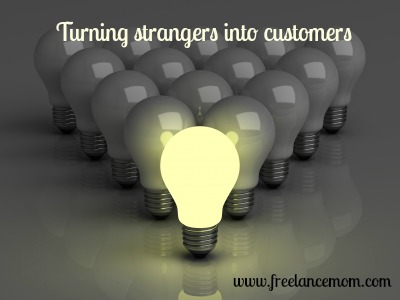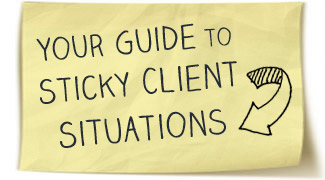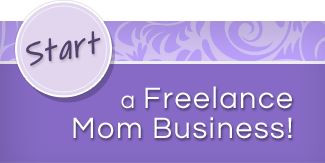
Lately here at FreelanceMom.com, we’ve been talking a lot about ideal clients—how to determine who they are and how to find them.
But now we’re going to talk about how to make sure they actually turn from complete strangers to prospects and, ultimately, into customers.
First Things First, What’s the Sales Cycle?
In business circles, this process has many names—the sales cycle, the customer decision journey, etc.—and many other versions, from the basic boiled down three-step process to the myriad varieties of five-step and seven-step processes. Some people talk about phases, others touch points, and others call them moments.
For our purposes in this guide, we’re going to work around the basic three-step process: awareness, evaluation, and purchase.
- Awareness: prospects realize that you may be able to fill their needs
- Evaluation: prospects examine the features and benefits of your offerings to see if you are the best fit for their needs
- Purchase: prospects physically complete the process of buying from you
Reaching and Converting Clients in the “Awareness” Stage
Customers can become aware of your brand in dozens of ways:
- hearing about you through their network
- seeing one of your ads
- following a link on another website to your page
- seeing someone else using one of your products
- arriving through a Google search for information
This phase is the first introduction to you and your services for all prospects, but, in the “awareness” stage, customers may or may not yet be looking to purchase at the moment. These two types of prospects need to be handled differently.
Customers who come across you when they are currently looking for solutions are the easiest to close in some ways. They want something now, and you need to give them easy access to the tools to make the decision to purchase from you.
With prospects like these, who often come through a search engine or a link from another website, a segment-focused pop-over with a discount code or other special offer can move the process along more quickly.
For customers that become aware of your brand in a moment when they are not ready to purchase right away, the most important thing you can do is to find a way to stay front of mind. Your goal with this segment is to offer information to help make a decision and build trust so the need is filled with a purchase from your brand.
Capturing email addresses is the industry standard and most powerful way to accomplish these objectives, and you can go about it in several ways:
- pop-overs
- free e-books on sign-up
- free webinar or autoresponder courses on sign-up
- comment contents
- other giveaways
Turning Prospects into Customers in the “Evaluation” Stage
When someone is looking to buy and evaluating whether you fit their need, they need key pieces of information:
- the features and benefits of your product or service
- the price of your product or service
- how your product or service is different from other providers
- how others have felt about your product or service
Providing this information can be difficult for self-employed women who offer services.
You don’t want to advertise rates because they really do vary depending on the project, its timeline, and the other variables involved. Likewise, advertising certain services might turn away prospects looking for other services you’re able to provide, but listing too many services may make you not look specialized enough to other prospects.
If you don’t want to box yourself in, add the caveat “additional services available on request” or “sample pricing for XYZ services with ABC terms only.”
The bottom line, however, is that a future customer visiting your website must have an immediate sense of what you do, how you do it, how much it will cost them, and how they will benefit from it. Otherwise they will only ever be a prospect looking for information who moves onto the next site.
Like the awareness stage, the evaluation stage works differently depending on whether a prospect is looking to make a purchase right now or down the line.
You need to provide these details in different ways for different types of customers.
People who are looking to buy right now will find this information in your product descriptions and sales pages, and it should always live there.
BUT….
For prospects that are on a slower path to purchasing, the information you provide during the evaluation stage is crucial not only for making sure the purchase eventually happens with you instead of another provider, but also for bringing the prospect to the point of purchase.
To help prospects who aren’t yet ready to buy evaluate your services, you need to go beyond price, features, benefits, and testimonials and win them over with your personality—or your company’s personality.
People buy from brands they like.
How can you draw prospects into your unique value proposition over time?
- concise, relevant blogs that demonstrate your knowledge
- newsletters offering special deals and a glimpse of your paid products for free
- tweeting highly useful (and/or entertaining) information
- insightful Facebook or Google posts that spark discussion and provide solutions (Gary Vanderchuk talks extensively about this in his new book – JJJRH)
Converting Prospects into Customers and Repeat Customers in the “Purchase” Stage
When prospects are ready to purchase, the most important thing you can do is get out of their way. Make it clear how to buy and make the process easy.
Having to click too many times decreases sales. Making prospects scroll too much or hunt for a buy button and a price can have similar effects.
Once your prospect has a burning need and trusts that your offering will fill it, there’s not much selling you need to do. But you can certainly upsell.
When offered one option, prospective buyers have two ways to go: yes or no. When they have two choices, they can go high or low. But when they have three choices, you get a Goldilocks effect.
Some prospects go the big, some want the cheapest option, but most settle for the middle choice—the “just right” option between two extremes.
In the purchase step, you can use this psychological tactic to move customers from a basic version of your product or service to one with a little something extra for them and for you.
If you are offering a coaching session, offer it three ways:
- the session by itself
- the session paired with an e-book that can enhance the ground covered in the session or help implement the techniques from the session (affiliate sell someone else’s book if you don’t have your own)
- a package of many sessions at a “discounted” bulk rate, plus the e-book
Have you found other ways to make more sales during different moments of your sales process?
Photo credit: Freedigitalphotos.net





